
Sorption Science Webinars/Workshops Directory
To keep up to date with our upcoming events please visit: https://www.surfacemeasurementsystems.com/learning-center/webinars/
| Responsible | Daniel Villalobos |
|---|---|
| Last Update | 21/11/2025 |
| Completion Time | 1 day 4 hours 1 minute |
| Members | 249 |
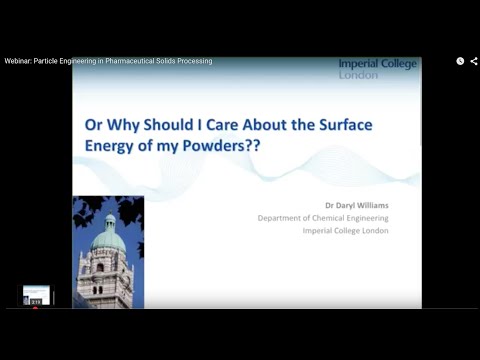
Webinar title: Particle Engineering in Pharmaceutical Solids Processing: Surface Energy Considerations
Topic: This webinar presented by Dr Daryl Williams from Imperial College London reviews the surface energy and surface energy heterogeneity of crystalline solids, methods for the measurement of surface energy, effects of milling on powder surface energy, adhesion and cohesion on powder mixtures, crystal habits and surface energy, surface energy and powder granulation processes.
For more information visit our website:
www.surfacemeasurementsystems.com
LinkedIn: https://www.linkedin.com/company/surface-measurement-systems
Twitter: https://twitter.com/surfacemsystems
Pharmaceuticals
View all
Webinar title: Particle Engineering in Pharmaceutical Solids Processing: Surface Energy Considerations
Topic: This webinar presented by Dr Daryl Williams from Imperial College London reviews the surface energy and surface energy heterogeneity of crystalline solids, methods for the measurement of surface energy, effects of milling on powder surface energy, adhesion and cohesion on powder mixtures, crystal habits and surface energy, surface energy and powder granulation processes.
For more information visit our website:
www.surfacemeasurementsystems.com
LinkedIn: https://www.linkedin.com/company/surface-measurement-systems
Twitter: https://twitter.com/surfacemsystems
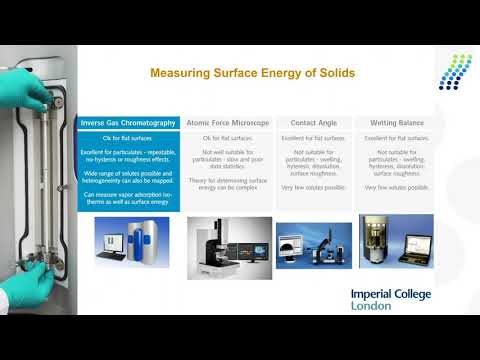
Presented by Prof. Daryl Williams from Imperial College London, this educational and informative webinar discussed the study of the role of solid state surface chemistry on the high shear granulation performance of a model pharmaceutical solids.
Hosted by Dr. Sabiyah Ahmad, Application Scientist, Surface Measurement Systems.
Website: https://www.surfacemeasurementsystems.com/learning-center/webinars/
Email: science@surfacemeasurementsystems.com
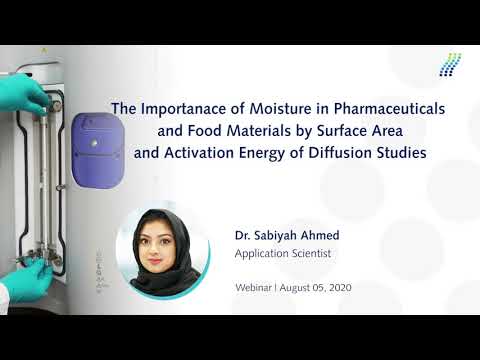
The Importance of Moisture in Pharmaceutical and Food Materials by Surface Area and Activation Energy of Diffusion Studies
Sorption techniques have been used to study the state of water molecules and their role in physicochemical stability of pharmaceutical and food materials. The sorption data has been used to measure the surface area and activation energy of diffusion for as received and modified pharmaceutical ingredients. Change in the temperature significantly influences the amount of the sorbed and desorbed water. The overall conclusion could be translated in the drying phase of the final pharmaceutical formulation.
Presenter: Dr. Sabiyah Ahmed, Application Scientist for DVS and iGC-SEA
Website: https://www.surfacemeasurementsystems.com/learning-center/webinars/
Email: science@surfacemeasurementsystems.com
Porous materials characterisation
View all
With the release of the DVS Carbon, researchers now have a powerful, purpose-built tool for characterizing materials for Carbon Capture, Utilization, and Storage (CCUS) applications. With unique measurement and engineering capabilities, we are excited to demonstrate what this new instrument can do! In this webinar, Product Manager Dr. Paul Iacomi takes the audience through the unique features of this innovative instrument, having a closer look at the DVS Carbon’s capabilities in action. Case studies on the instrument’s applications, including Direct Air Capture and Post-combustion Capture, show how to utilize the DVS Carbon in your own research.

This workshop was organized with Universität Magdeburg and explores advanced and innovative sorption techniques for analyzing catalysts, adsorbents, and functional materials for heat pumps. Delivered by the world’s leading sorption instrumentation specialists, Surface Measurement Systems, the session dives into the advanced gravimetric sorption technique, Dynamic Vapor Sorption (DVS). This webinar provides insight into applications for studying zeolites, binary co-sorption of MOFs, VOC capture, silica gels and adsorption heat pumps.

Spanish Seminario : Métodos experimentales para la captura de CO2 en presencia de vapor de agua
Cellulose
View all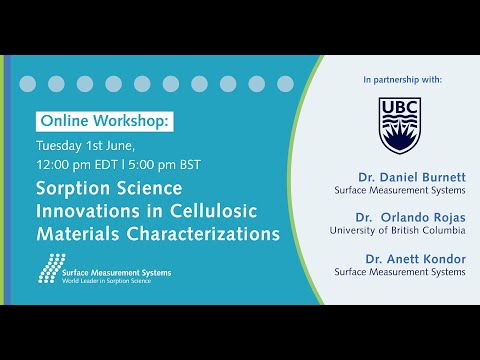
Surface Measurement Systems and the University of British Columbia collaborated to provide three in-depth presentations exploring the latest research, case studies, and findings. This workshop offers unparalleled insight into the use of sorption science techniques in the field of cellulosic materials and characterization.
Characterization of Cellulose-based Materials by Dynamic Vapor Sorption with Dr. Daniel Burnett
Cellulose is the most abundant organic polymer on Earth, and can be found in plants, marine animals, algae, and bacteria. Depending on the source of the cellulose and the chemical treatment, the resulting material can vary in crystal structure, degree of crystallinity, surface chemistry, morphology and aspect ratio. Therefore, it is critical to fully characterize surface and bulk properties of cellulose, nanocellulose, and cellulose-based materials to understand formulation and development challenges, composite performance, storage conditions, and processing behavior. This educational and informational webinar focuses on the use of Dynamic Vapor Sorption to study these surface and bulk properties of cellulose, nanocellulose and wood-based materials.
Structures and Surface Interactions in Plant-based Materials: From Particles to Thin films with Dr. Orlando Rojas
We use various lignocellulose sources to prepare particles and thin films, for example, by spin coating, Langmuir deposition or convective assembly from dispersed and multiphase media. A combination of bi-component systems have been produced as 2D structures that include bicontinuous morphologies. Such structures are translated into microfibers with the assistance of electrospinning, wet and dry spinning. Changes in the surface energy behaviors, morphology and other characteristics are determined as a function of chemical conversion, which enable surface energy switching. This allows for possibilities in the development of new materials and platforms, for example, in sensing, control release and optical devices, some of which will be illustrated. We make use of lignin particles and ligno-nanocellulosic filaments as examples of systems with tailorable water sorption and surface energy, as characterized by methods such as dynamic vapor sorption and inverse gas chromatography.
Comprehensive Surface Characterization of Cellulose-Based Materials using Inverse Gas Chromatography and other Sorption Techniques with Dr. Anett Kondor
The applicability and capability of sorption techniques for comprehensive surface characterization of fibers including natural fibers, ligno-cellulosic fibers, cellulose nano-fibrils (CNFs), cellulose nano-crystals (CNCs) are proved and presented in several studies. This presentation provides comprehensive surface characterization of recycled and non-recycled cellulose-based bathroom tissues including the dispersive and specific surface free energy, acid-base properties, and BET specific surface area, furthermore, complete water sorption and desorption behavior at 25 C. In addition, it presents a critical overview of the specific surface area analysis of cellulosic materials.
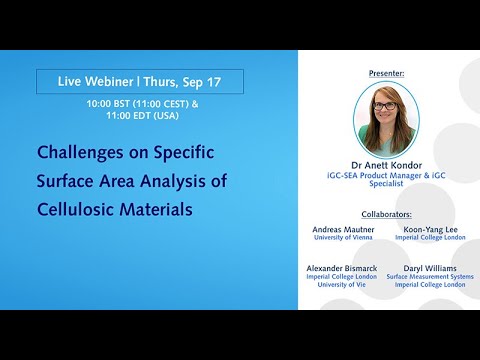
Presented by Dr. Anett Kondor
The interaction of a solid with its surroundings is through the available surface area for adsorption of gas or vapour molecules. This also allows probing of materials surface including irregularities and pores. One of the most successful methods is based on the BET method for gas adsorption onto a solid surface. The adsorption method of Brunauer, Emmett and Teller (BET) is based on the physical adsorption of a vapour or gas onto the surface of a solid. Traditionally, sorption studies were carried out at low temperatures to obtain nitrogen isotherms at 77 K, which were then used to calculate BET surface areas. Considering that material behavior varies with temperature, measurements at ambient temperatures may be more relevant and also allow the use of various gases and vapours.
The present study is devoted to a critical investigation of the specific surface area analysis of cellulosic materials, such as freeze-dried bacterial cellulose, cellulose nano-paper and crystalline cellulose powder by gas and vapour adsorption using dynamic vapour sorption (DVS) technique, volumetric technique and inverse Gas Chromatographic (iGC) technique and the favourable case of cellulosic materials is emphasized. Inorganic materials including the specific surface area standard materials can be successfully measured with these techniques, however, the applicability of these techniques on organic materials has to be appraised.
Food
View all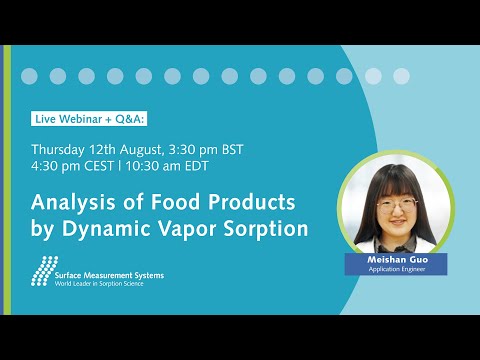
When Food & its ingredients are capable of absorbing up to 50% by mass of moisture from the air, knowing the sorption properties of your food product is essential to the R&D process. In this, Dynamic Vapor Sorption provides an unparalleled level of insight. Invented by Surface Measurement Systems’ Founder, Dr. Daryl Williams, the DVS technique enables researchers incredible levels of detail and accuracy in the physico-chemical characterization of solid-state materials.
To learn more go to: https://bit.ly/3AGzUba
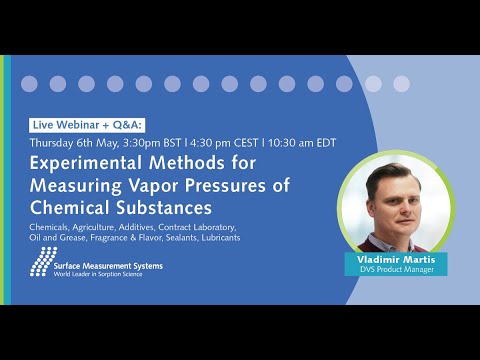
Dr. Vladimir Martis, Surface Measurement Systems resident expert in Vapor Pressure, shares valuable insights and recent research findings for the Knudsen Effusion Method and Static Method for Vapor Pressure Measurement. Attendees also had a great opportunity to engage Dr. Martis directly in a live Q&A.
Vapor pressure is defined as the pressure exerted by vapor in thermodynamic equilibrium with its condensed phases (solid or liquid) at a given temperature in a closed system. It is an important physicochemical property for many applications including human health, environmental protection, vapor phase deposition processes, lubricants operational life and separation processes. In addition, the vapor pressure thermodynamic data can be used to calculate enthalpies of vaporization or sublimation. Therefore, the accurate determination of vapor pressure is fundamental for the development of models simulating the behaviour of chemicals in industrial processes or outdoor environments. There are several methods for measuring vapor pressures, as it is difficult for a single experimental method to cover entire range of vapor pressures from less than 10-15 to 105 Pa.
In this webinar, we discussed the Knudsen effusion method and static method for vapor pressure measurement. The Knudsen effusion method is used for measuring sublimation or evaporation processes below 100 Pa in the temperature range from 293 to 673K. The static method has been developed to extend the measured pressure range up to 105 Pa in the temperature range between 293 and 323K. Also, it is capable of measuring vapor pressures of liquid samples, or crystalline solids.
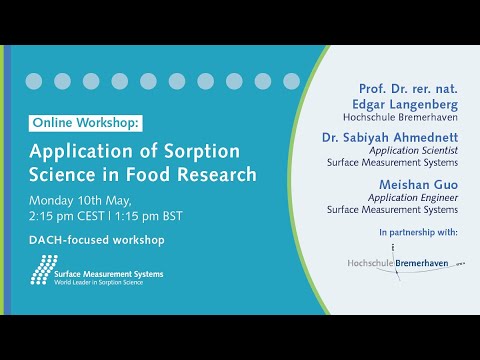
Accurate and detailed insight into sorption properties and surface energy is essential to sector of consumer product research; but nowhere is this more important than in the food sector. This free-to-attend online workshop explores two innovative techniques, Dynamic Vapor Sorption (DVS) and Inverse Gas Chromatography (IGC), and how they can provide unparalleled insight in the study of food.
Abstracts:
DVS and its applications in Food
The moisture sorption properties of food materials are fundamental considerations for development and enhancement of food products, since they may influence the stability and performance during processing, storage and product use. Dynamic Vapour Sorption (DVS) has long been used for investigating the interaction of water vapour with foods and food ingredients. The combination of a video microscope and vibrational spectroscopic techniques with DVS would allow for increased understanding of vapor-induced structural changes of solid materials. This workshop summarises several examples of using DVS for food-related applications including water activity, moisture content, moisture-induced phase transitions, water-vapour transmission rates, and flavour loss.
iGC and its applications in Food
The increasing sophistication of food ingredients has created the need for new techniques to measure the physico-chemical properties of a wide range of food materials. IGC – SEA is specially designed to determine the surface energy heterogeneity but nevertheless suitable for measuring different surface and bulk properties of solid materials including powder surface energies, acid/base/polar functionality of surfaces, diffusion kinetics, surface heterogeneity and phase transition temperatures/humidities.
Building Materials
View all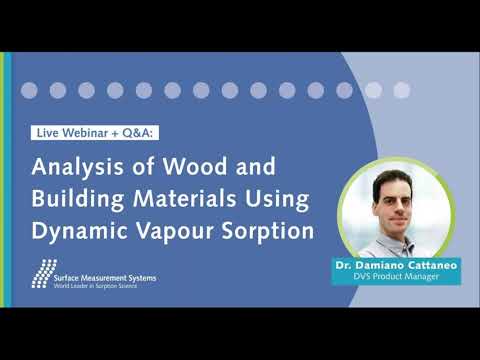
When considering any material for use in construction, knowing how it reacts to moisture is essential to architectural integrity and safety. Dynamic Vapor Sorption, the innovative sorption analysis technique pioneered by Surface Measurement Systems, provides unparalleled insight and accuracy into how various building materials react to moisture under varying conditions.
This free-to-attend webinar explores how the DVS method is employed in the physico-chemical characterization of wood and other building materials, and the insights it provides into how they react to moisture.
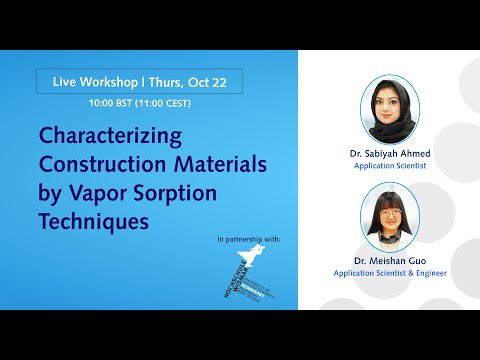
Presenters:
Prof. Dr.-Ing. Winfried Malorny (University of Wismar)
Dr. Meishan Guo, Application Scientist & Engineer, Surface Measurement Systems
Dr. Sabiyah Ahmed, Application Scientist, Surface Measurement Systems
Characterizing construction and building materials? Join us for this free online workshop to discover how you can maximize the accuracy and detail of your research using Vapor Sorption Techniques.
Organized in partnership with the University of Applied Sciences in Wismar, this session is a vital resource for any working in the following fields of research:
-Wood
-Cement
-Building Materials
What will you learn?
Dynamic Vapor Sorption (DVS):
1. Measuring the Moisture Sorption Kinetics of Cements using DVS.
2. Measuring BET Surface Areas Using Organic Probe Molecules.
3. Determination of Surface Energetics of Mineral Aggregates Used in Asphalt by DVS.
4. Determination of True Density by Dynamic Vapour Sorption.
5. Characterizing the Restoration Materials for Historic Buildings.
Invert Gas Chromatography (iGC-SEA):
1. An investigation of minerals used in asphalt by inverse gas chromatography.
2. Study of composites – considering steel fibers in cement or concrete as composite
Polymers
View all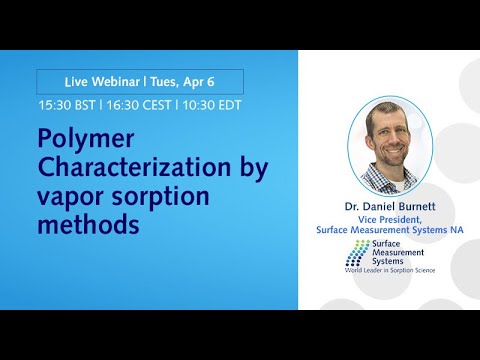
This session will explores well-established vapor sorption techniques of Dynamic Vapor Sorption (DVS) and Inverse Gas Chromatography (IGC). With a focus on applications, the webinar delves into the physicochemical characterization capabilities offered by the DVS and IGC, specific to polymers and films.
In particular to IGC, practical examples and case studies are given that cover a wide range of relevant problems, including surface energetics, wetting behavior, composite adhesion/cohesion phenomena, solubility parameters, and glass transitions.
Related to DVS, examples and case studies are reviewed that provide insight into moisture sorption properties, drying kinetics, vapor-induced phase changes, and vapor diffusion/permeability studies. Also, the hypenization of the DVS with video microscopy and Raman spectroscopy is discussed including examples on relevant materials.
General Applications
View all
In the fight against climate change, DAC has emerged as a promising solution to remove carbon dioxide directly from the atmosphere, offering a sustainable pathway to mitigate greenhouse gas emissions. This webinar brings together leading experts in the field who explore the latest advancements in DAC technology, with a particular focus on the role of adsorption processes. Researchers from Imperial College London discuss recent findings and key technological considerations for advancing Direct Air Capture (DAC) through adsorption. This will be followed by a presentation from Dr. Paul Iacomi, Product Manager of DVS Carbon, who provides detailed practical case studies showcasing DAC in action using advanced sorption instrumentation.
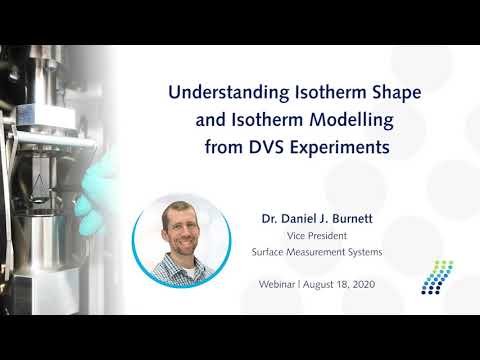
Dynamic Vapor Sorption (DVS) instruments are commonly used to measure sorption isotherms on a diverse array of materials, including powders, fibers, films, particulates, and other solid surfaces. These isotherms can be obtained with various gases and vapors over a wide range of temperatures. Isotherm size, shape and hysteresis can elucidate mechanistic information about vapor/gas-solid interactions. Further, by applying the correct isotherm models, it is possible to determine additional material properties, such as surface areas, monolayer capacities, micro- and meso-porosity, and sorption enthalpies. This educational and informational webinar focuses on the interpretation of isotherm attributes and the application of various surface and bulk isotherm models.
Presenter: Dr. Daniel J. Burnett
Host: Brad McGroarty
Website: https://www.surfacemeasurementsystems.com/learning-center/webinars/
Email: science@surfacemeasurementsystems.com
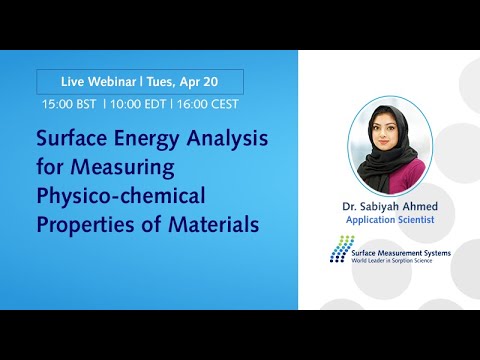
This webinar covers an in-depth introduction to the Inverse Gas Chromatography – Surface Energy Analyser (iGC-SEA) technique and the concept of surface energy. It explores the versatility of the iGC-SEA technique and how it can be used in the study of pharmaceuticals, polymers, carbon materials and fibres. The case studies presented highlight the use of the system to measure BET specific surface area, surface energy and surface heterogeneity. Studies also demonstrate the effects of changing conditions of temperature and humidity on materials.
Hair
View all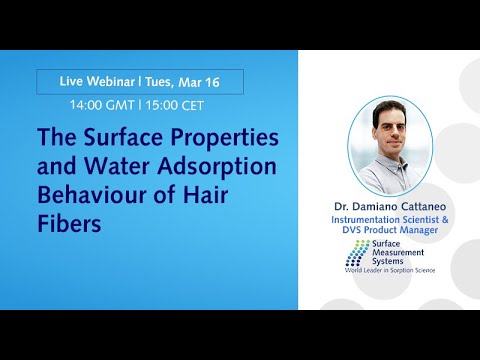
Speaker: Dr. Damiano Cattaneo, DVS Product Manager, Surface Measurement Systems
Abstract:
Water should be considered an integral part of hair’s complex structure due to its considerable influence on fiber properties. However, this water content is not constant and varies with the relative humidity of the environment – and accordingly so do certain hair properties. These changing properties are behind the ability to create temporary so-called “water-set“ hairstyles – but they also represent the origin of eventual style failure. At the same time, consumers worry greatly about the water content of their hair and the potential for “drying out” – where there is a demand for “moisturizing” or “hydrating products” if this perceived situation is realized. The interaction of hair and water can represent a probe into the inner structure and there is a need for a means of accurately measuring hair’s water content.
Fuel cells
View all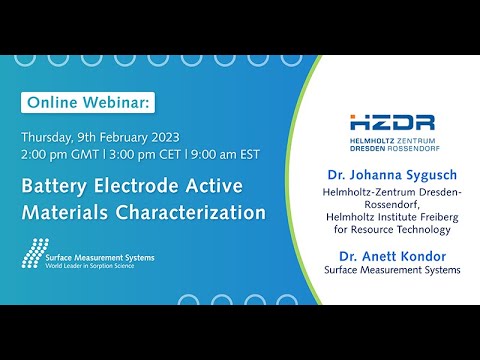
Nowadays many electronic devices are being operated by batteries, including everyday devices (e.g. laptop and smartphones), healthcare devices (e.g. toothbrush), tools, toys, and vehicles as well. The use of batteries is forecast to increase significantly in the upcoming years. Therefore, the development of long and high-performance batteries and also the need to recycle spent batteries in order to ensure the supply of critical raw materials increased significantly in the last years, but is a complex task since the individual batteries have rather complex structures and varying composition.
During the development of the battery materials, temperature stability is one of the key parameters besides energy density, power density, lifetime, charging rate, cost and safety. Furthermore, the understanding of the surface properties and interfacial interactions of the anode and cathode materials is crucial in order to improve and develop efficient manufacturing and recycling processes.
In this webinar we present the surface and interfacial properties of different cathode (LCO, NMC, LFP) and anode (natural and synthetic graphite) materials. Characteristic properties include the specific surface area, the surface energetics at different temperatures measured with inverse Gas Chromatography (IGC) as well as water and cyclohexane sorption behaviour by Dynamic Vapour Sorption (DVS). Furthermore, we are going to present some results on wettability characterization using optical contour analysis and the Washburn method, as well as bubble-attachment and analytical particle solvent extraction tests. We also discuss which challenges arise during the recycling of spent lithium ion batteries by using the separation process of froth flotation.
Dr. Sygusch and Dr. Kondor will, among other things, give a detailed introduction to the Inverse Gas Chromatography and Dunamic Vapor Sorption techniques. With a live Q&A to finish the session, this is an unmissable opportunity to gain fresh insight into this vitally important topic from two leading experts.
Carbon Capture
View all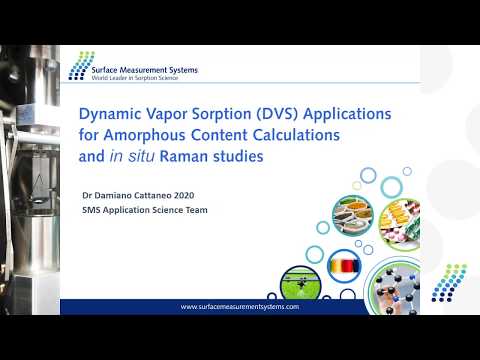
In this webinar, Dr. Damiano Cattaneo highlighted some examples of case studies such as amorphous content calculation and glass transition Tg RH (the critical relative humidity at the specific glass transition temperature). Moreover, we will focus on the characterization of an in situ study of camera and Raman applications during a DVS experiment. Website: https://www.surfacemeasurementsystems.com/ Future webinars: https://www.surfacemeasurementsystems.com/learning-center/webinars/ Email us: science@surfacemeasurementsystems.com
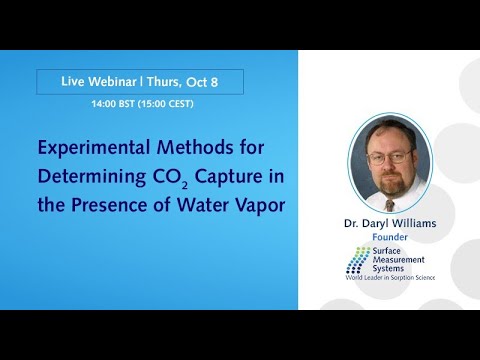
Presenter:
Dr. Daryl Williams
Founder
Surface Measurement Systems
In the real world, capture/adsorption of CO2 is often a competition with other gas-phase species, most commonly water vapour. In some cases, the concentration of H20 vapor is much higher than that of CO2 further complicating the adsorption process.
This presentation, delivered by one of the world’s leading authorities in sorption science, Dr. Daryl Williams, will compare the use of two of the most commonly used experimental approaches for studying CO2 sorption in the presence of H20 vapor; gravimetric analysis using Dynamic Vapour Sorption (DVS) and breakthrough analyzer studies. To give the audience maximum insight, experimental details and case study comparisons of adsorbent performance will also be presented